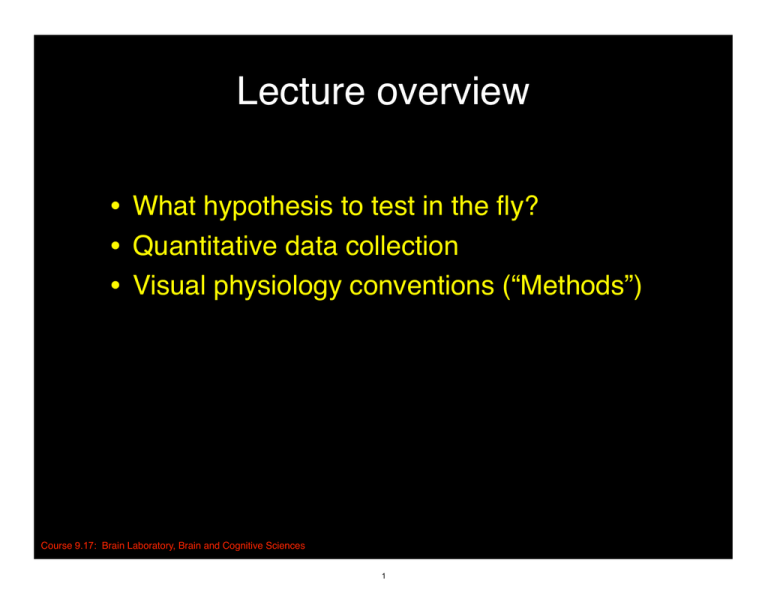
Lecture overview
• What hypothesis to test in the fly?
• Quantitative data collection
• Visual physiology conventions (“Methods”)
Course 9.17: Brain Laboratory, Brain and Cognitive Sciences
1
Lecture overview
• What hypothesis to test in the fly?
• Quantitative data collection
• Visual physiology conventions (“Methods”)
Course 9.17: Brain Laboratory, Brain and Cognitive Sciences
2
“Encoding”
Stimuli
“Decoding”
Neuronal codes
Behavior
General situation in vision encoding studies:
Independent variable: pattern of photons
Dependent variable: pattern of spikes from one or
more neurons
A specific case (e.g. for H1 in the fly):
Independent variable: direction of a moving grating
Dependent variable: spike rate during each the
presentation of each grating
spikes per unit time (spikes/sec)
Course 9.17: Brain Laboratory, Brain and Cognitive Sciences
3
Example of quantitative neurophysiology:
orientation tuning a neuron in primary visual cortex
(area V1) of the monkey.
Function fit to
the average
responses
One of our overarching goals is to teach
you how these kind of plots are produced.
You will do all the steps yourself!
From Dayan, Peter, and L. F. Abbott. Theoretical Neuroscience: Computational and Mathematical Modeling
of Neural Systems. MIT Press, 2001. © Massachusetts Institute of Technology. Used with permission.
Course 9.17: Brain Laboratory, Brain and Cognitive Sciences
4
Overall goal of the fly labs: the basics of carrying out a
complete, quantitative neurophysiology experiment.
• Design visual stimuli to test a
hypothesis
• Setup a prep to record from
relevant
neurons
A hypothesis about the
your
visualvisual
stimuli
in a
• Present
relationship
between
stimuli
controlled,
repeatable
and a neuronal
response manner
• Collect digital data during that
presentation
• Isolate individual spikes in that data
• Analyze the relationship between
spike responses and visual stimuli
• Document your findings
Course 9.17: Brain Laboratory, Brain and Cognitive Sciences
5
MATLAB proj 2
Design lab
FLY wet lab 1
FLY wet lab 2
FLY wet lab 2
MATLAB proj 1
MATLAB proj 3
Data analysis lab
Lab Report 2
Lecture overview
• What hypothesis to test in the fly?
• Quantitative data collection
• Visual physiology conventions (“Methods”)
Course 9.17: Brain Laboratory, Brain and Cognitive Sciences
6
Basic electrophysiological setup
Analog to
digital device
(A to D)
Photon stimulation
(retinal receptors)
LCD screen
trigger pulse (start A to D)
Display
computer
Synchronization pulses
Course 9.17: Brain Laboratory, Brain and Cognitive Sciences
7
Data
collection
computer
We must have some way of saving the voltage signal
so that we can find the spikes (action potentials) later
A single action
potential
Analog
Analog to digital
device (A to D)
Digital
Number of samples taken every second:
1000
(1 kHz sampling)
2000
(2 kHz sampling)
4000
(4 kHz sampling)
What sampling rate is optimal?
1 ms (1/1000 sec)
Reprinted by permission from Macmillan Publishers Ltd: Nature.
Source: Hodgkin, A. L., and A. F. Huxley. "Action Potentials
Recorded from Inside a Nerve Fibre." Nature 144
(1946): 710-11. © 1946.
Course 9.17: Brain Laboratory, Brain and Cognitive Sciences
Are there downsides to sampling faster?
*Sample at 2x the highest frequency in the signal to
get a perfect reproduction of the signal (= “Nyquist
sampling rate”).
8
Basic electrophysiological setup
Analog to
digital device
(A to D)
Photon stimulation
(retinal receptors)
LCD screen
trigger pulse (start A to D)
Display
computer
Synchronization pulses
Course 9.17: Brain Laboratory, Brain and Cognitive Sciences
9
Data
collection
computer
We must have some way of aligning (synchronizing)
the visual stimulus with the recorded voltage
0 ms 1500 ms
2500 2900 ms
Visual stimulus:
Voltage near
neuron:
spikes per unit time (spikes/sec)
Times of action
potentials (‘spikes’):
Course 9.17: Brain Laboratory, Brain and Cognitive Sciences
10
First steps to quantitative physiology (science):
• Ability to accurately repeat conditions.
• Control of variables -- only change one thing
at a time!
Stimulus run 1:
Stimulus run 2:
Course 9.17: Brain Laboratory, Brain and Cognitive Sciences
11
Example voltage traces
Stimulus:
Voltage near
neuron on run 1:
Voltage near
neuron on run 2:
Course 9.17: Brain Laboratory, Brain and Cognitive Sciences
12
Lecture overview
• What hypothesis to test in the fly?
• Quantitative data collection
• Visual physiology conventions (“Methods”)
Course 9.17: Brain Laboratory, Brain and Cognitive Sciences
13
Standard units of visual stimuli
Distance on retina:
1 millimeter
Screen distance: 1.5 meters
3.5-degree
angle
Distance on screen:
89 millimeters
Rays of light
Image by MIT OpenCourseWare.
Stimulus size: degrees of visual angle (deg)
E.g. “The white square subtended approximately 4 deg x 4 deg of
visual angle”
Speed of motion: degrees of visual angle covered per
unit time (deg/sec)
E.g. “The white square was moved from left to right at a speed of
40 deg/s.”
Course 9.17: Brain Laboratory, Brain and Cognitive Sciences
14
deg (elevation)
Standard units of visual stimuli:
receptive field maps in vertebrates
Center of
receptive field
Size (diameter)
of receptive field
© MGraw-Hill Companies. All rights reserved. This content is
excluded from our Creative Commons license. For more
information, see http://ocw.mit.edu/help/faq-fair-use/.
0
Center of gaze (center
of the retina)
0
deg (azimuth)
Course 9.17: Brain Laboratory, Brain and Cognitive Sciences
15
deg (elevation)
Standard units of visual stimuli:
receptive field map
Receptive field
of a neuron
0
0
deg (azimuth)
Course 9.17: Brain Laboratory, Brain and Cognitive Sciences
16
Center of visual axis of
the fly
Fly visual field: state your conventions!
Course 9.17: Brain Laboratory, Brain and Cognitive Sciences
17
Things that should be in your movie:
1) First ~10 sec: test a large drifting grating in eight different
directions around the clock. At least 500 ms between each
of these stimulus conditions.
2) Stimulus conditions to test your main hypothesis.
Your group is responsible for keeping track of the times
of the start and end of each stimulus condition in your
movie.
Course 9.17: Brain Laboratory, Brain and Cognitive Sciences
18
MIT OpenCourseWare
http://ocw.mit.edu
9.17 Systems Neuroscience Lab
Spring 2013
For information about citing these materials or our Terms of Use, visit: http://ocw.mit.edu/terms.






